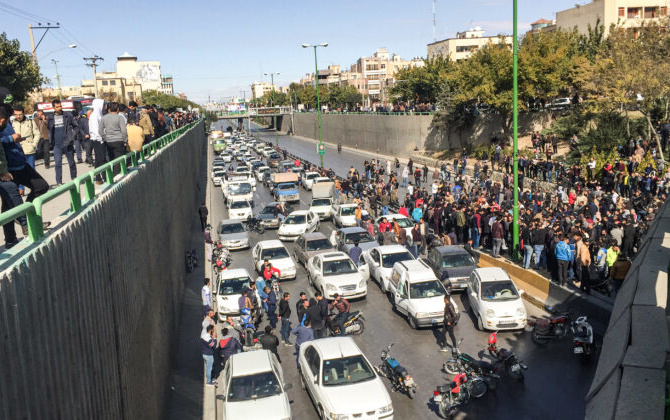Iranian protesters block a road during a demonstration against an increase in gasoline prices, Isfahan, November 16, 2019 (AFP)
Updating the death toll from Iran’s mass protests over rising petrol prices, Amnesty International says at least 143 people have been killed.
In a report published Monday, Amnesty writes of verfied video of “security forces deliberately shooting unarmed protesters at close range”, refusal to return bodies to families, and injured being removed from hospitals.
The organization criticized the “the international community’s cautious and muted response to the unlawful killing of protesters [as] woefully inadequate”.
The demonstrations began on November 15, after a midnight announcement by the Government that petrol subsidies would be cut, raising the cost by 50%. They quickly spread through the country, leading the regime to mobilize security forces and to cut 95% of Internet access.
The Supreme Leader intervened to say the protests were instigated by foreign actors, relatives of the late Shah, and the “terrorist” Mojahedin-e Khalq organization. Iranian authorities arrested more than 1,000 protesters, including 100 “ringleaders”, and said scores of banks and Government buildings were burnt.
Since Wednesday, the regime has declared victory over “armed anarchists”. But it has betrayed concern over the “miracle” in vanquishing the demonstrations, and continue to warn of a “crushing response” to other countries.
Iranian officials have not given an official death toll. State media have highlighted the funerals of a Revolutionary Guards member and a civilian, but ignored the killing of any demonstrators.
Amnesty said almost all the killings of protesters have been from “the intentional use of firearms by the security forces”, with one man reported to have died after inhaling tear gas and another after being beaten.
The organization warned that the death toll may be significantly higher than 143.
The report is based on accounts from eyewitnesses and victims’ relatives, information from human rights activists and journalists outside Iran, and video footage.
It noted footage of some protesters shot while running away and security forces firing from rooftops of Government buildings.
Citing the intimidation of families, Amnesty said they have been threatened with arrest if they hold funerals for the slain or speak to members of the media.
Of the 143 killed, 40 were in Khuzestan Province in southwest Iran, 34 in Kermanshah Province in the west, 20 in or near the capital Tehran, and 12 in Iranian Kurdistan.


““the international community’s cautious and muted response to the unlawful killing of protesters [as] woefully inadequate”.”
I have another 20 years of public life left in me, I’ll remember the germans, the french and britts in due course…
“143+ Killed in Petrol Protests — Amnesty”
Yes, as if “petrol” was the one thing people protested against….